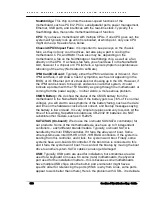
G A L A X Y ® A U R O U R A C O N F I G U R A T I O N A N D S Y S T E M I N T E G R A T I O N G U I D E
122
Section 4 Troubleshooting Guide
the client, as long as only one port is used. It then connects to the cable that
either goes to the switch or the client. On Infiniband, on a stock switch, there is
no zoning to worry about – the data flow is determined by the client and not
the switch. The cable connects to a port on the client. The client is running an
OS. Now on the software side of things on the client, there are two
components: IBSRP and OpenSM. At least one machine on the Infiniband
network must be running OpenSM – it is the most critical piece of software. If it
is not running, you won’t get a connection. Also if there is only one machine on
the network running OpenSM, and it is rebooted or otherwise locks up, it will
kick out the other clients. Also, if the machine running OpenSM is the only one
and is dedicated, it must be booted first in order for the other clients to see it.
Also on the clients is IBSRP (And the Infiniband driver itself, not mentioned
here). On Windows, IBSRP is run as a service. On Linux, it must be manually
loaded. There are two LEDs on the Infiniband cards for each port: One
indicates the status of OpenSM: If you only see one LED, either there is a
cabling problem, or no subnet manager is running on that network. If the other
LED doesn’t blink, then probably IBSRP isn’t running or there is some other
software problem.






























